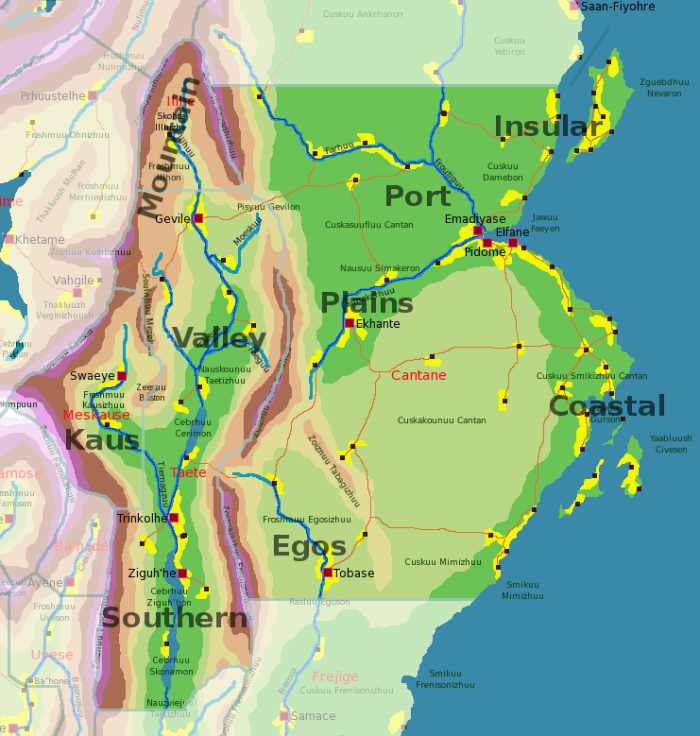Gevey dialects
The Gevey language is not a static entity: it is continually developing and evolving, with changes in sounds, words and grammar accumalating with each orbit. These changes occur in different places and between different groups of people unevenly, and as a result a number of dialects have evolved.
Three factors in particular have encouraged the development of dialects:
- geographical spread
- socio-economic circumstances
- peer group exclusivity
Geographical dialects
Geography has proved to be the main reason for the development of dialects - because of the mountainous nature of the interior of the continent, travel between communities has tended to be limited.
The main differences between geographical dialects have been phonological and lexical. Across the various Gevey dialects, consonant sounds tend to be more conservative than vowel sounds; the changes in the sounds assigned to particular vowels tends to be consistent within a particular dialect across the lexicon, though variations and exceptions can be found in different neighbourhoods and peer groups. Gevey speakers have a strong tendency to write the language as they speak it, which can lead to spelling variation across dialects, though the spoken dialects remain (for the most part) mutually intelligible to all speakers, once they've tuned their ear to the local phonetic idiosyncracies.
Lexical differences are much more obvious; different words will exist for a given object or action in different dialects. While these lexical differences are not numerous, they often occur in very common objects and actions which makes their impact much more noticable.
Linguists agree that there are 10 distinct geographical dialects currently existing in Gevey, though there is of course variation within each recognised dialect and the borders between some of the dialects is debatable. The dialects are (in no particular order):
- Mountain - spoken in particular in the Skaobe Illjixe (Illje) and other mountain areas, considered to be a relic form of the language
- Kaus - concentrated in Swaeye and the Frjocmu Kausixu (Meskause)
- Valley - the reference dialect centred on Gevile and the Nauskounu Taetixu (Taete)
- Égos - least similar dialect to the reference, spoken in Tobase and the Frjocmu Égosixu (Tcantane)
- Coastal - spoken across the Tcuesku Smikixu Tcantan and Yaabluc Tcivesen (Tcantane), thought of as a rustic version of the Port dialect
- Plains - used to be more widespread, now seems to be limited to Éqante and the Nausu Simakerjon (TCantane)
- Port - the dialect with the most speakers, concentrated in the cities of Êmadiyase, Pidome and Élfane (though each city claims to have its own dialect), and northwest along the Froutigu and Faru rivers (Tcantane)
- Insular - restricted to Zyuubdju Nevarjon and the Tcuesku Damebon
- Southern - a major dialect centred around the cities of Ziguihe and Trjinkolje (Taete)

Socio-economic dialects
The major socio-economic dialect is of course Trade Gevey, which operates a full range of phonemes, a restricted lexicon and a base 8 counting system imported directly from the Istran Society language. The trade dialect is spoken widely across the eastern half of the continent.
Two other major socio-economic dialects can be found throughout the Gevey speaking region: Monastic Gevey and Collegic Gevey, the second being the preferred dialect of skilled professionals such as healers and higher level teachers. It is noticable that when people across the Gevey speaking region become self-consciously aware of how they are speaking (such as in interviews, or reciting poetry) they will begin to pick up attributes of Collegic Gevey - such as the overtrilled 'rh' and dental 't' and 'd'. Monastic Gevey, on the other hand, has little influence over the general population, though everybody can parody the rhythmic cadences of the dialect when required.
Peer group exclusivity
The ways in which different peer groups subtly change the Gevey language to make it their own is seemingly incalculable. But the reason why every peer group distorts the language is to set up a subtle barrier between those included in the group and the rest of the neighbourhood or region. The range of peer groups is also extensive - from family units, through work gangs and trade guilds, to generational cohorts.
Most peer group dialects will be a distortion of the underlying geographical dialect. Phonemic changes are rare, with lexical anomalies being the preferred external markers of the peer group. But grammatical differences also exist. For instance, each peer group will have a preferred word order, with some preferring to front the subject in neutral sentences, others the principal verb and yet others the direct object.